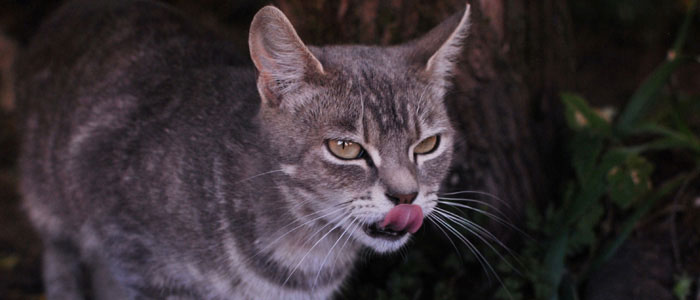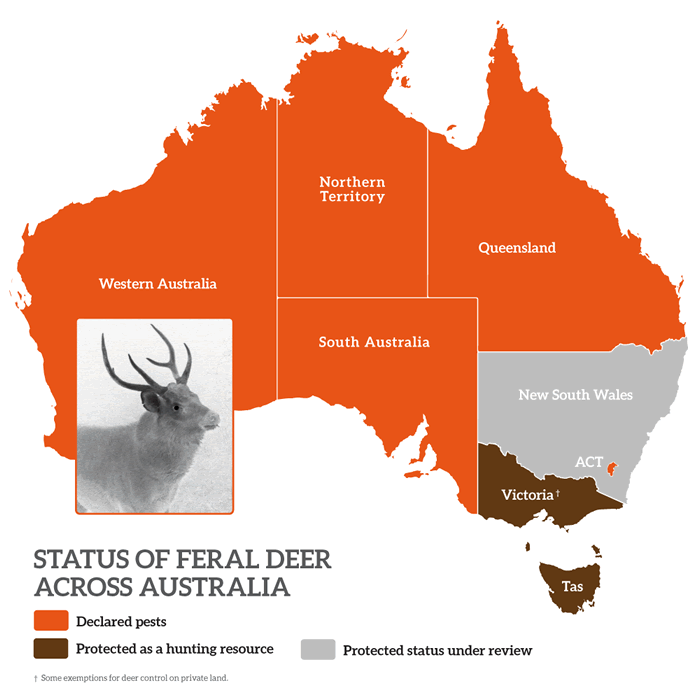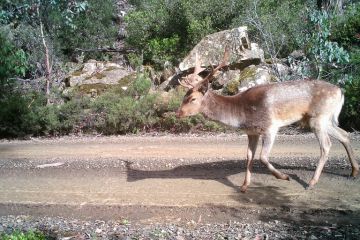
Inquiry into the problem of feral and domestic cats
Our joint submission to the Australian Government’s inquiry into the problem of feral and domestic cats includes strengthening regulations for cat-free islands.

Our joint submission to the Australian Government’s inquiry into the problem of feral and domestic cats includes strengthening regulations for cat-free islands.

A report into the ethical considerations of using 1080 to control feral animals has found the conservation benefits necessitate its use until an alternative is available.

Submission to the Australian Senate inquiry into the impacts of feral deer, pigs and goats in Australia, November 2018.

Submitted: April 2018
A joint submission with the Nature Conservation Council of NSW that provides 16 detailed recommendations to strengthen the draft regional pest animal plans and reduce the impacts of pest animals in NSW.

Australia is in the midst of an extinction crisis. We have the worst mammalian extinction record in the world, with cats helping drive two thirds of these. We cannot continue to allow cats to decimate our native animals. We must act today, before it is too late.

Feral pigs are on the brink of causing an environmental catastrophe in Tasmania.

A deadly bird flu virus is killing wildlife around the globe.. From Asia to Antarctica, the new deadly strain of bird flu has infected over 500 bird species and 60 mammal species, devastating wildlife populations and threatening local extinctions. As the only continent still free of the virus, time is running out to prepare Australia for its arrival.

Australia is in the midst of an extinction crisis. We have the worst mammalian extinction record in the world, with cats helping drive two thirds of these. We cannot continue to allow cats to decimate our native animals. We must act today, before it is too late.

Australia is in the midst of an extinction crisis. We have the worst mammalian extinction record in the world, with cats helping drive two thirds of these. We cannot continue to allow cats to decimate our native animals. We must act today, before it is too late.

Australia is in the midst of an extinction crisis. We have the worst mammalian extinction record in the world, with cats helping drive two thirds of these. We cannot continue to allow cats to decimate our native animals. We must act today, before it is too late.

Submitted: September 2016
Due to their rising numbers and effect on natural ecosystems, deer are the most important emerging vertebrate pest in eastern Australia. Recreational hunting generally provides little or no benefit to feral animal control. Volunteer shooting can assist feral animal control in a limited number of circumstances.

Submitted: August 2016
The goal of the draft wild horse management plan for Kosciuszko National Park to set a 20-year target to drastically reduce feral horse numbers is supported, but the prospect of the plan succeeding is limited because the plan prohibits the use of aerial shooting as a control method.

Submitted: May 2016
A joint submission that largely supports the draft report and recommendations. In particular the submission supports the proposal to declare deer as a pest animal.

Feral deer numbers have exploded across Tasmania, damaging native vegetation and ecologically fragile areas, costing farmers and forestry millions each year, and are becoming a serious hazard on the road.

Feral deer numbers have exploded across Tasmania, damaging native vegetation and ecologically fragile areas, costing farmers and forestry millions each year, and are becoming a serious hazard on the road.

Our joint submission to the Australian Government’s inquiry into the problem of feral and domestic cats includes strengthening regulations for cat-free islands.

A report into the ethical considerations of using 1080 to control feral animals has found the conservation benefits necessitate its use until an alternative is available.

Submission to the Australian Senate inquiry into the impacts of feral deer, pigs and goats in Australia, November 2018.

Submitted: April 2018
A joint submission with the Nature Conservation Council of NSW that provides 16 detailed recommendations to strengthen the draft regional pest animal plans and reduce the impacts of pest animals in NSW.

Australia is in the midst of an extinction crisis. We have the worst mammalian extinction record in the world, with cats helping drive two thirds of these. We cannot continue to allow cats to decimate our native animals. We must act today, before it is too late.

Feral pigs are on the brink of causing an environmental catastrophe in Tasmania.

A deadly bird flu virus is killing wildlife around the globe.. From Asia to Antarctica, the new deadly strain of bird flu has infected over 500 bird species and 60 mammal species, devastating wildlife populations and threatening local extinctions. As the only continent still free of the virus, time is running out to prepare Australia for its arrival.

Australia is in the midst of an extinction crisis. We have the worst mammalian extinction record in the world, with cats helping drive two thirds of these. We cannot continue to allow cats to decimate our native animals. We must act today, before it is too late.

Australia is in the midst of an extinction crisis. We have the worst mammalian extinction record in the world, with cats helping drive two thirds of these. We cannot continue to allow cats to decimate our native animals. We must act today, before it is too late.

Australia is in the midst of an extinction crisis. We have the worst mammalian extinction record in the world, with cats helping drive two thirds of these. We cannot continue to allow cats to decimate our native animals. We must act today, before it is too late.

Submitted: September 2016
Due to their rising numbers and effect on natural ecosystems, deer are the most important emerging vertebrate pest in eastern Australia. Recreational hunting generally provides little or no benefit to feral animal control. Volunteer shooting can assist feral animal control in a limited number of circumstances.

Submitted: August 2016
The goal of the draft wild horse management plan for Kosciuszko National Park to set a 20-year target to drastically reduce feral horse numbers is supported, but the prospect of the plan succeeding is limited because the plan prohibits the use of aerial shooting as a control method.

Submitted: May 2016
A joint submission that largely supports the draft report and recommendations. In particular the submission supports the proposal to declare deer as a pest animal.

Feral deer numbers have exploded across Tasmania, damaging native vegetation and ecologically fragile areas, costing farmers and forestry millions each year, and are becoming a serious hazard on the road.

Feral deer numbers have exploded across Tasmania, damaging native vegetation and ecologically fragile areas, costing farmers and forestry millions each year, and are becoming a serious hazard on the road.

Our joint submission to the Australian Government’s inquiry into the problem of feral and domestic cats includes strengthening regulations for cat-free islands.

A report into the ethical considerations of using 1080 to control feral animals has found the conservation benefits necessitate its use until an alternative is available.

Submission to the Australian Senate inquiry into the impacts of feral deer, pigs and goats in Australia, November 2018.

Submitted: April 2018
A joint submission with the Nature Conservation Council of NSW that provides 16 detailed recommendations to strengthen the draft regional pest animal plans and reduce the impacts of pest animals in NSW.

Australia is in the midst of an extinction crisis. We have the worst mammalian extinction record in the world, with cats helping drive two thirds of these. We cannot continue to allow cats to decimate our native animals. We must act today, before it is too late.

Feral pigs are on the brink of causing an environmental catastrophe in Tasmania.

A deadly bird flu virus is killing wildlife around the globe.. From Asia to Antarctica, the new deadly strain of bird flu has infected over 500 bird species and 60 mammal species, devastating wildlife populations and threatening local extinctions. As the only continent still free of the virus, time is running out to prepare Australia for its arrival.

Australia is in the midst of an extinction crisis. We have the worst mammalian extinction record in the world, with cats helping drive two thirds of these. We cannot continue to allow cats to decimate our native animals. We must act today, before it is too late.

Australia is in the midst of an extinction crisis. We have the worst mammalian extinction record in the world, with cats helping drive two thirds of these. We cannot continue to allow cats to decimate our native animals. We must act today, before it is too late.

Australia is in the midst of an extinction crisis. We have the worst mammalian extinction record in the world, with cats helping drive two thirds of these. We cannot continue to allow cats to decimate our native animals. We must act today, before it is too late.

Submitted: September 2016
Due to their rising numbers and effect on natural ecosystems, deer are the most important emerging vertebrate pest in eastern Australia. Recreational hunting generally provides little or no benefit to feral animal control. Volunteer shooting can assist feral animal control in a limited number of circumstances.

Submitted: August 2016
The goal of the draft wild horse management plan for Kosciuszko National Park to set a 20-year target to drastically reduce feral horse numbers is supported, but the prospect of the plan succeeding is limited because the plan prohibits the use of aerial shooting as a control method.

Submitted: May 2016
A joint submission that largely supports the draft report and recommendations. In particular the submission supports the proposal to declare deer as a pest animal.

Feral deer numbers have exploded across Tasmania, damaging native vegetation and ecologically fragile areas, costing farmers and forestry millions each year, and are becoming a serious hazard on the road.

Feral deer numbers have exploded across Tasmania, damaging native vegetation and ecologically fragile areas, costing farmers and forestry millions each year, and are becoming a serious hazard on the road.
Get our blog the Feral Herald delivered to your inbox.
Our protected areas are being trashed, trampled, choked and polluted by an onslaught of invaders. Invasive species are already the overwhelming driver of our animal extinction rate, and are expected to cause 75 of the next 100 extinctions.
But you can help to turn this around and create a wildlife revival in Australia.
From numbats to night parrots, a tax-deductible donation today can help defend our wildlife against the threat of invasive weeds, predators, and diseases.
As the only national advocacy environment group dedicated to stopping this mega threat, your gift will make a big difference.
A silent crisis is unfolding across Australia. Every year, billions of native animals are hunted and killed by cats and foxes. Fire ants continue to spread and threaten human health. And the deadly strain of bird flu looms on the horizon. Your donation today will be used to put the invasive species threat in the media, make invasive species a government priority, ensure governments take rapid action to protect nature and our remarkable native wildlife from invasives-led extinction, death and destruction.
If you are having trouble submitting a form, please read this guide.
Please fill out the following form and one of our team will be in contact to assist as soon as possible. Please make sure to include any helpful information, such as the device you were using (computer, tablet or mobile phone) and if known, your browser (Mozilla Firefox, Chrome, Safari etc)
"*" indicates required fields
Dear Project Team,
[YOUR PERSONALISED MESSAGE WILL APPEAR HERE.]
I support the amendment to the Kosciuszko National Park Wild Horse Heritage Management Plan to allow our incredible National Parks staff to use aerial shooting as one method to rapidly reduce feral horse numbers. I want to see feral horse numbers urgently reduced in order to save the national park and our native wildlife that live there.
The current approach is not solving the problem. Feral horse numbers have rapidly increased in Kosciuszko National Park to around 18,000, a 30% jump in just the past 2 years. With the population so high, thousands of feral horses need to be removed annually to reduce numbers and stop our National Park becoming a horse paddock. Aerial shooting, undertaken humanely and safely by professionals using standard protocols, is the only way this can happen.
The government’s own management plan for feral horses states that ‘if undertaken in accordance with best practice, aerial shooting can have the lowest negative animal welfare impacts of all lethal control methods’.
This humane and effective practice is already used across Australia to manage hundreds of thousands of feral animals like horses, deer, pigs, and goats.
Trapping and rehoming of feral horses has been used in Kosciuszko National Park for well over a decade but has consistently failed to reduce the population, has delayed meaningful action and is expensive. There are too many feral horses in the Alps and not enough demand for rehoming for it to be relied upon for the reduction of the population.
Fertility control as a management tool is only effective for a small, geographically isolated, and accessible population of feral horses where the management outcome sought is to maintain the population at its current size. It is not a viable option to reduce the large and growing feral horse population in the vast and rugged terrain of Kosciuszko National Park.
Feral horses are trashing and trampling our sensitive alpine ecosystems and streams, causing the decline and extinction of native animals. The federal government’s Threatened Species Scientific Committee has stated that feral horses ‘may be the crucial factor that causes final extinction’ for 12 alpine species.
I recognise the sad reality that urgent and humane measures are necessary to urgently remove the horses or they will destroy the Snowies and the native wildlife that call the mountains home. I support a healthy national park where native species like the Corroboree Frog and Mountain Pygmy Possum can thrive.
Dear Project Team,
[YOUR PERSONALISED MESSAGE WILL APPEAR HERE.]
I support the amendment to the Kosciuszko National Park Wild Horse Heritage Management Plan to allow our incredible National Parks staff to use aerial shooting as one method to rapidly reduce feral horse numbers. I want to see feral horse numbers urgently reduced in order to save the national park and our native wildlife that live there.
The current approach is not solving the problem. Feral horse numbers have rapidly increased in Kosciuszko National Park to around 18,000, a 30% jump in just the past 2 years. With the population so high, thousands of feral horses need to be removed annually to reduce numbers and stop our National Park becoming a horse paddock. Aerial shooting, undertaken humanely and safely by professionals using standard protocols, is the only way this can happen.
The government’s own management plan for feral horses states that ‘if undertaken in accordance with best practice, aerial shooting can have the lowest negative animal welfare impacts of all lethal control methods’.
This humane and effective practice is already used across Australia to manage hundreds of thousands of feral animals like horses, deer, pigs, and goats.
Trapping and rehoming of feral horses has been used in Kosciuszko National Park for well over a decade but has consistently failed to reduce the population, has delayed meaningful action and is expensive. There are too many feral horses in the Alps and not enough demand for rehoming for it to be relied upon for the reduction of the population.
Fertility control as a management tool is only effective for a small, geographically isolated, and accessible population of feral horses where the management outcome sought is to maintain the population at its current size. It is not a viable option to reduce the large and growing feral horse population in the vast and rugged terrain of Kosciuszko National Park.
Feral horses are trashing and trampling our sensitive alpine ecosystems and streams, causing the decline and extinction of native animals. The federal government’s Threatened Species Scientific Committee has stated that feral horses ‘may be the crucial factor that causes final extinction’ for 12 alpine species.
I recognise the sad reality that urgent and humane measures are necessary to urgently remove the horses or they will destroy the Snowies and the native wildlife that call the mountains home. I support a healthy national park where native species like the Corroboree Frog and Mountain Pygmy Possum can thrive.